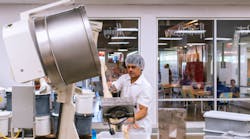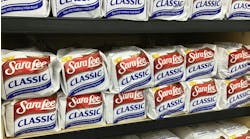In the baking business, the simplest way to make more money is to make more dough.
Expanding operations to increase output, a frequent challenge throughout the food industry, became more intense for many sectors during the pandemic, especially baking. As consumers sheltered at home, demand for baked goods shot up. In one week in March 2020, the first full month of Covid's impact in the U.S., grocery store sales of baked goods rose 62%; for the full year 2020, bread sales went up about 10% over 2019.
But the simplest way is not always the easiest way. Expanding output in baking, whether of a single product or an entire operation, brings some unique challenges because of the nature of baked goods.
“The first thing that everyone thinks is, well, I have to double my production,” says Gary Seiffer, a consultant and former baker and equipment sales manager. “Well, doubling production doesn’t necessarily mean buy another line. You’ve got to balance all the equipment.”
One of the most basic challenges is that in most baking there are going to be bottlenecks where capacity is constrained around a single, crucial step. In many bakeries, that is liable to be the oven.
“Running dough faster through makeup lines is easy, but when it comes to proofing, baking, cooling, then you’ve got to start thinking 'Do I need one big cooler and one big oven, or do I maybe go with two ovens that maybe will handle the capacity,' ” Seiffer says. “The No. 1 mistake that I have seen is they don’t look at the whole process. They’re looking at a stage.”
Up from batches
An obvious way to ramp up production is to move from batch to continuous processing. In baking, that often translates to moving from batch-style rack ovens to tunnel or spiral ovens. Not only is this a significant capital expense that requires extra space, but it almost always necessitates wholesale, fundamental shifts in the entire process.
To produce enough dough to keep the ovens busy, more space may be required for proofing and resting dough; to match production downstream might require additional capacity for cooling product out of the oven, for packaging or for other operations.
There are other operational aspects that need adjusting. For example, if bake time varies between products, a system based on a tunnel oven would need some way of accommodating this – either by adjusting the oven, possibly through temperature zones, or by varying the conveyor belt speed through the oven. Some sort of accumulation or other accommodation of excess capacity might also be needed for products with shorter bake time.
Companion Baking broke down the time and steps needed to make each product as a first step toward increasing efficiency.
If installing a continuous oven is not an option, rack ovens are available that use automation to increase efficiency. Companion Baking, a St. Louis-based bakery that processes specialty breads and rolls, uses a rack oven from Miwe International that uses robots to slide racks in and out.
Other kinds of equipment can make a difference. Needing to ramp up production a few years ago, Companion Baking bought an expanded version of a dough processing line from Rheon. The new line is about 60 ft. long, roughly six times the length of the previous one. It’s gentler, runs more smoothly and doesn’t leave as much trim, according to operations manager Suman Shekar. It can be programmed for frequent changeover – Companion does about 20 a day – and cuts down on the two to three inches of trim per dough strip that the old system wasted, Shekar says.
All hands on deck
If new equipment of any kind is not in the picture, a bakery that needs more throughput often has little choice but to hire more hands.
Seiffer recalls a bakery he owned that supplied rolls to the New York City market. Faced with increased demand, they cut out the step of retarding the dough after it had been cut into roll shapes. This shortened the output time by six hours but lowered the quality.
“On a humid day, our hard rolls were sponges, like they’d been in a rubber bag all night,” Seiffer says. They ended up hiring four more people, two for each shift, so they would be able to place the rolls face down in a pan and retard them in a refrigerator for the required six hours.
If increasing labor is no more an option than adding equipment, getting more output out of the people and equipment you have is the only alternative.
Shekar said that in the summer of 2017, she was charged with increasing productivity at Companion Baking. She literally walked around with a timer and clipboard, seeing how long and how much labor was involved in each step of the process.
Eventually, Companion incorporated a labor-tracking system from Redzone. It takes performance data, directly from an Excel spreadsheet if needed, and breaks it down into an efficiency analysis. The results can be shown on a display, also furnished by Redzone, that tells each shift and line how they’re doing.
Packing up
In many cases, a bakery’s big barrier to increased production comes from packaging. There’s little point in increasing production capacity if the packaging operation can’t keep up.
When the pandemic took hold in early 2020, Companion Baking, like many bakeries, found itself whipsawed by shifting demand. Its foodservice business sharply declined as restaurants closed or shifted to delivery-only. But Companion’s sales force was able to drum up new retail business among grocers whose customers were seeking comfort foods like bread. They were so successful that it created a surge that production had to respond to.
“There was no chance of us saying no [to the new orders], because at that time we needed it,” Shekar recalls. The trouble was that their packaging equipment – specifically end-of-line equipment – couldn’t handle the extra loads. “We ran into the issue where we were growing and we were unable to put product inside a case and palletize it and send it out the door in time, and we had trucks on the back of our dock.”
Companion installed a palletizing cobot – a “collaborative robot,” designed to operate safely in proximity to human workers. The cobot was from Fanuc, programmed and installed by MMCI Automation. The cobot enabled Companion to increase output from 20 to 30 pallets a day.
One of the biggest challenges had been stacking cases by hand on the top layer of a pallet load that reaches higher than 86 inches; the cobot, of course, can reach that high with no problem at all. “It’s been one of the hugest game-changers in the back,” Shekar says. “It really makes us feel that packing is no problem at all.”
Special grippers, like this one from Soft Robotics, enable robots to handle delicate products like baked goods.
Robots can be incorporated further up the packaging line, but other adjustments have to be made. If they are expected to handle unpackaged product, they probably will need special end-of-arm tooling to enable gentle handling, available from vendors like Soft Robotics.
“Our mGrip and mGripAI solutions are easy to integrate, enabling the deployment of robots in food processing previously reliant on human labor,” says Julie Collura, director of marketing communications at Soft Robotics. “mGrip’s proven soft gripper technology allows robots to safely and efficiently pick and pack products while also increasing throughput and efficiency.”
Ramping up production in industrial baking poses many challenges, some unique, others common to all food operations. Judicious equipment upgrades, in processing, packaging or both, often are the key to meeting those challenges.


